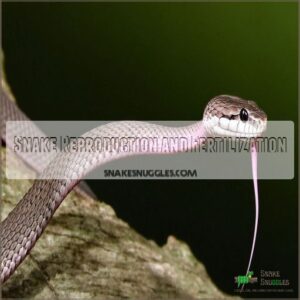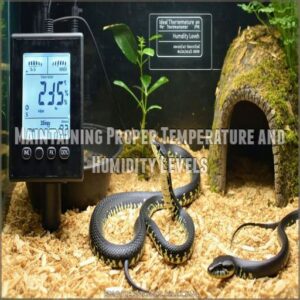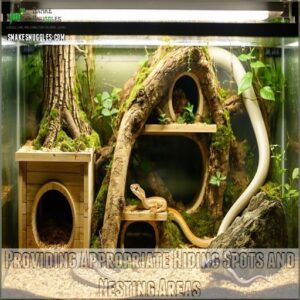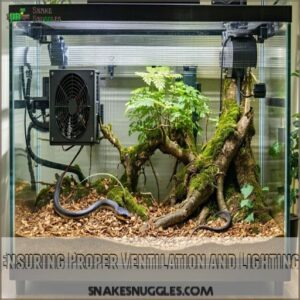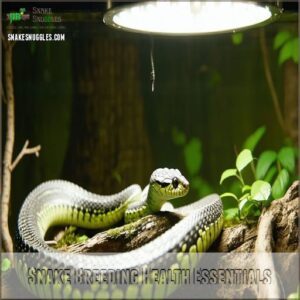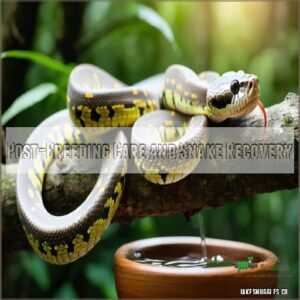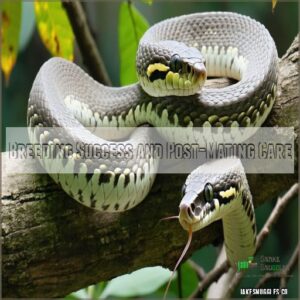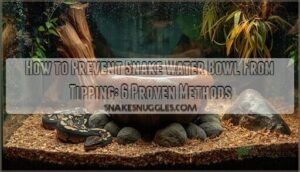This site is supported by our readers. We may earn a commission, at no cost to you, if you purchase through links.
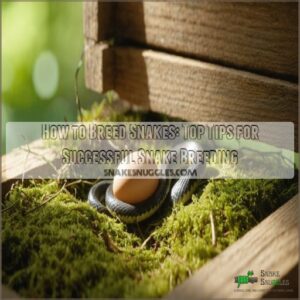
Accurately identify their genders—getting this right is key!
Mimic the natural brumation period with reduced temperatures and light exposure; snakes need this to trigger mating instincts.
Then, introduce the male to the female’s enclosure and keep an eye out for tail-locking, a sure sign of success.
Set up a cozy nesting box for the female to lay eggs, ensuring proper humidity and ventilation.
Once laid, incubate the eggs with stable conditions.
Curious about myths like "sperm storage"?
There’s more to unravel in snake breeding!
Table Of Contents
- Key Takeaways
- Preparing Snakes for Breeding
- Breeding Snakes Successfully
- Snake Reproduction and Fertilization
- Creating a Safe and Healthy Breeding Environment
- Nutrition and Diet for Breeding Snakes
- Managing Stress and Disease in Breeding Snakes
- Caring for Pregnant or Gravid Snakes
- Snake Breeding Health Essentials
- Post-Breeding Care and Snake Recovery
- Breeding Success and Post-Mating Care
- Frequently Asked Questions (FAQs)
- What are the most dangerous snake breeds?
- What are the most popular snake breeds?
- What are some of the best pet snakes for beginners?
- What is the rarest snake in the world?
- How Long Does It Take for Snake Eggs to Hatch?
- What is the Best Way to Handle Snakes During the Breeding Process?
- What Type of Environment Should I Provide for the Snake Babies?
- Are There Any Special Dietary Needs for Snakes During Breeding Season?
- How Often Should I Check on the Eggs or Snake Babies?
- How do I get my snakes to breed?
- How does snake breeding work?
- What is the easiest snake breed to own?
- How do you become a snake breeder?
- What are the signs of snake courting?
- How does brumation affect snake fertility?
- Can snake pheromones influence mating success?
- What are common parasites in breeding snakes?
- How do temperature fluctuations impact breeding?
- Conclusion
Key Takeaways
- Ensure healthy and compatible snakes by sexing them correctly and preparing them for breeding with appropriate temperature and light cycles.
- Manage temperature, humidity, and photoperiod to mimic natural conditions, promoting fertility and successful breeding.
- Provide a nutrient-rich diet with protein and supplements like calcium and vitamin D3 to meet the increased nutritional needs during breeding.
- Monitor for health issues and stress to maintain snake well-being, enabling a successful breeding process and healthy offspring.
Preparing Snakes for Breeding
Before you begin breeding snakes, you’ll need to prepare your reptiles for the process.
This involves carefully separating the males and females.
You’ll also need to gradually lower the temperature to mimic a natural cooling period.
Separating Sexes and Stopping Feeding
Ready to get started with snake breeding? First, separate the sexes to prevent premature mating. Second, stop feeding them to manage weight and reduce stress before the breeding season.
Here’s a quick checklist to follow:
- Sexing snakes correctly.
- Adjusting their feeding schedule.
- Setting up the right enclosure.
- Monitoring their health closely.
Cooling Period and Temperature Control
Think of brumation as a snake’s winter nap, important for breeding success.
Lower temperatures mimic their natural cycles.
Keep daytime around 75-83°F, and nighttime at 70-73°F for 90 days.
This cooling period sets the stage for reproductive readiness.
| Temperature | Duration |
|---|---|
| Daytime | 75-83°F |
| Nighttime | 70-73°F |
Humidity and Photoperiod Management
Maintaining the right humidity and photoperiod is like orchestrating a symphony for your snake’s breeding success. Use reptile lighting to simulate natural seasonal cycles, boosting your snake’s mood and breeding readiness.
Pay attention to:
- Humidity control: Keep it balanced; too high leads to mold.
- Brumation impact: Mimic cooler, shorter days.
- Temperature consistency: Avoid drastic fluctuations.
- Photoperiod effects: Extend daylight gradually.
Duration of Cooling Period
Understanding the details of photoperiods can lead you to the duration of the cooling period.
It varies with snake species but generally lasts about 60-90 days.
During brumation, lower temperatures promote successful breeding cycles.
As temperatures rise and daylight exposure increases, signaling hormonal changes and ideal conditions for breeding season care. Imagine it as a snake’s version of winter break, fostering ideal conditions for snake reproduction and ensuring readiness for the breeding season.
Breeding Snakes Successfully
Now that you’ve set the stage for snake breeding, it’s all about crafting the right conditions for success. Providing the best environment and care means your snakes will be healthy and ready to mate. Here are some snake breeding tips to keep in mind:
- Keep a close watch on their interactions — understanding snake behavior helps you know when they’re ready.
- Ensure ethical considerations — prioritize genetic diversity to avoid health problems.
- Focus on snake health and care — providing proper nutrition and stress management is key. For optimal nutrition, consider investing in high-quality snake breeding food supplies from reputable sources like snake breeding food products.
Breeding snakes can feel like a balancing act, but with patience and observation, you’ll manage it like a pro. Knowing your snake’s "language" makes all the difference in achieving snake breeding success.
Snake Reproduction and Fertilization
Understanding snake reproduction and fertilization, including factors like breeding readiness signs of snake breeding readiness, is key to successful breeding.
Male snakes use their unique reproductive anatomy, including hemipenes, to fertilize the female’s eggs.
Pay attention to pheromone trails for mate selection.
Don’t be surprised by parthenogenesis in some snake species, where females can produce offspring without a male.
Pheromone Trails and Mate Selection
Many snakes rely on scent, not sight, to find mates.
Males follow pheromone trails, basically a chemical love letter, left by females.
This is pheromone detection in action!
Successful mating hinges on a female’s choice.
Here’s a helpful guide:
| Pheromone Type | Source | Detection Method | Role in Mating | Success Rate |
|---|---|---|---|---|
| Skin Gland Pheromones | Female | Vomeronasal Organ | Mate Attraction | High |
| Volatile Compounds | Female | Olfactory System | Distance Signaling | Moderate |
| Facial Glands Pheromones | Male | Vomeronasal Organ | Courtship Rituals | Low |
| Cloacal Glands Pheromones | Female | Vomeronasal Organ | Mate Recognition | High |
| Tail Glands Pheromones | Male | Vomeronasal Organ | Mate Competition | Moderate |
Hemipenes and Snake Reproductive Anatomy
You’ve ever wondered how snake mating works?
Male snakes possess a unique hemipenes system which enables successful reproduction during mating. The snake reproductive system is fascinating! Males use hemipenes—paired organs—to mate through the female’s cloaca.
This intricate dance includes:
- Hemipenes for transfer
- Cloaca function: a shared exit for feces and eggs
- Mating rituals: male snakes entwine around females
- Avoiding hemipene prolapse
- Ensuring proper snake sexing
Sperm Storage and Fertilization
Understanding sperm storage can give you an edge in snake breeding.
Female snakes can store viable sperm for extended periods, waiting for the perfect moment to fertilize their eggs.
This nifty trick allows for better control over egg development and can lead to healthy offspring.
Male snakes face sperm competition, so efficient fertilization is key to successful reptile reproduction.
Parthenogenesis in Some Snake Species
Parthenogenesis, a wonder of asexual reproduction, lets some snake species skip the usual mating dance.
It’s like a backup plan, allowing females to reproduce without a male, boosting species diversity.
However, while this evolutionary benefit might stabilize populations, it can limit genetic variation, playing a tricky balancing act in snake breeding.
Knowing these nuances enriches your reptile reproduction insights.
Creating a Safe and Healthy Breeding Environment
When you’re setting up a breeding environment for your snakes, it’s important to maintain proper temperature and humidity levels to guarantee their health and comfort.
Hiding spots and nesting areas, along with good ventilation and lighting, are also essential for a successful breeding process.
Maintaining Proper Temperature and Humidity Levels
In snake reproduction, things don’t end at pheromone trails and mating rituals.
Keeping temperature gradients and humidity control in check can make or break your breeding success.
It’s like Goldilocks—everything must be just right.
Use proper enclosure ventilation and substrate selection with savvy heating methods.
This dynamic dance helps create a healthy snake breeding environment, guaranteeing your scaly friends are cozy and thriving.
Providing Appropriate Hiding Spots and Nesting Areas
When setting up your snake breeding enclosure, consider the ideal dimensions, which should be 1.5-2 times the length of the snake, and check out the best snake breeding enclosure setup for more information. Think of it like staging a serene hideaway. Provide cozy nesting areas for your snakes to feel secure.
Consider these steps:
- Choose soft substrates for nesting materials, like shredded coconut husk.
- Use different hiding spot types, such as logs or boxes, and consider purchasing a reptile hide box set.
- Place nesting boxes strategically, ensuring easy access.
Ensuring Proper Ventilation and Lighting
Proper ventilation is key; think of it as your snake’s personal air conditioner.
Stale air can lead to respiratory problems.
Good airflow prevents mold and keeps humidity in check.
Lighting mimics natural cycles, influencing breeding behavior.
Here’s a helpful guide:
| Lighting Type | Light Cycle (hours) | Benefits | Considerations | Issues |
|---|---|---|---|---|
| UVB | 10-12 | Promotes calcium absorption | Avoid overheating | Burns, eye problems |
| Heat Lamp | 12-14 | Provides basking spots | Monitor temperature carefully | Fire hazard |
| Full Spectrum | 12-14 | Mimics natural sunlight | Placement is crucial | May affect humidity |
| Red Night Light | 6-8 | Night vision, minimal impact | Limited use, not primary light | May disturb breeding cycles |
| None | 0 | Natural light (outdoors) | Seasonal considerations | Not suitable for indoor setups |
Good ventilation and the right lighting are essential for successful snake breeding.
Nutrition and Diet for Breeding Snakes
To make sure your breeding snakes thrive, you’ll need to tailor their diet to be nutrient-rich, focusing on protein-packed prey and essential supplements.
Remember, a well-fed snake is a happy snake, but watch out—overfeeding can lead to lazy coils and more snakeskin pants for shedding.
Dietary Requirements for Breeding Snakes
Feeding your breeding snakes requires a bit of savvy.
Aim for appropriately sized prey to match their needs, upping food frequency during breeding to boost protein intake.
Keep an eye on calcium needs to support snake breeding health considerations.
This snake breeding guide stresses that mastering dietary balance helps guarantee the success of your snake breeding endeavors.
Supplements for Breeding Snakes
You’ve got their diet sorted, so now think about supplements—snake breeding’s secret weapon.
Consider calcium and vitamin D3 for strong bones and healthy development.
Add multivitamins to the mix for overall well-being.
Don’t forget prebiotics and probiotics to keep their digestive system humming.
Your snake breeding setup isn’t complete without these nutritional powerhouses, ensuring your breeding snakes thrive.
Feeding Strategies for Optimal Health
Balancing snake nutrition can feel like juggling lizards. Opt for a feeding schedule that meets their dietary needs and supports breeding health.
Remember these tips:
- Prey Size: Match prey size to your snake’s width.
- Food Frequency: Feed more often when gravid.
- Supplements: Add vitamins to the menu.
- Dietary Needs: Tailor meals to species-specific requirements.
Managing Stress and Disease in Breeding Snakes
When you’re breeding snakes, keeping stress and disease at bay is essential for their health and successful reproduction.
Spotting early signs of stress or illness, like unusual aggression or shedding difficulties, can make all the difference in your breeding endeavors.
Addressing Health Issues in Breeding Snakes
When your snake seems off its game, watch for stress signs—refusing food, or getting grumpy.
Regular monitoring and a stress-free environment, like the one described in snake breeding health considerations Environmental Control for Snake Breeding Health, can help prevent these issues.
Keep an eye out for parasites like mites.
Respiratory issues might pop up if humidity’s out of whack.
Breeding snake health hinges on spot-on nutrition, so dodge those nutritional deficiencies with balanced meals.
By ensuring proper care, you’ll avoid breeding risks and complications.
Managing Stress in Pregnant Females
Successfully managing health issues paves the way for addressing stress in pregnant snakes.
A calm mama snake is a happy mama snake!
Minimize stress by:
- Maintaining consistent enclosure temperatures.
- Providing a nutritious pregnancy diet.
- Using gentle handling techniques.
These steps greatly reduce snake breeding risks, ensuring a smoother snake pregnancy.
Remember, a relaxed environment is key to healthy snake breeding.
Dealing With Unfertilized or Dead Eggs
Facing infertile or dead snake eggs is a common hiccup in breeding.
Inspect for signs of egg rotting or fungal growth.
Prompt egg removal prevents infection and spread of disease.
Incubation issues might mean tweaking incubation temperatures.
Think of it like gardening—sometimes, despite best efforts, not all seeds sprout.
Egg disposal is essential to maintain egg health and minimize snake breeding risks.
Caring for Pregnant or Gravid Snakes
When caring for pregnant or gravid snakes, you’ll need to make sure they receive proper nutrition and a well-controlled environment to support healthy development.
Monitor their health closely, and remember, even the calmest snake might get a bit cranky with extra hormones!
Identifying Pregnancy in Snakes
Noticing snake pregnancy might seem tricky at first.
Look for belly swelling and weight gain, clues that she’s prepping for egg production.
Behavior changes, like increased restlessness or cloacal adjustments, often signal snake gestation.
Understanding these breeding cycles helps you spot when your slippery friend is on her way to snake egg laying.
Keep an eye on these signs.
Dietary and Environmental Needs
To support a pregnant snake, focus on its environment and diet, and be aware of physical signs such as swelling and lumping in the midsection, noticeable changes in body shape and size, as described in identifying gravidity signs.
Fine-tune the enclosure setup for the best comfort with a suitable substrate choice and consistent water availability.
Adjust the feeding schedule, ensuring nutritious meals.
Monitor temperature and humidity—like crafting a climate-controlled spa—to mimic ideal brumation conditions.
Remember, happy snakes lead to successful snake breeding.
Monitoring Health and Development
As your gravid snake progresses, keep a keen eye on her health and development. Note any behavior changes, like increased shedding or unexpected weight gain.
- Check for parasites regularly.
- Monitor egg development closely for signs of complications.
- Track her overall health to guarantee a smooth path to motherhood.
Remember, keeping stress low aids in successful breeding.
Snake Breeding Health Essentials
To make sure your snake breeding efforts are successful, it’s important to understand the common health issues they might face.
A solid diet, stress management, and disease prevention play key roles in keeping your snakes healthy and ready to breed.
Common Health Issues in Breeding Snakes
Breeding snakes? Understanding potential health problems is key.
Keep an eye out for common issues like respiratory infections, parasites, and shedding problems.
Weight management is essential; a healthy weight helps prevent many complications.
It’s also a good idea to find a local reptile expert, such as a reptile vet near me, for guidance on snake care and health.
By implementing genetic testing guidelines, snake breeders can minimize the risk of genetic defects. Genetic defects can crop up, so responsible breeding practices are essential for snake breeding health.
Early detection is critical in snake breeding, minimizing snake breeding complications.
Remember, prevention is the best medicine in snake breeding best practices!
Role of Nutrition in Snake Health
A snake’s diet is important for breeding success. You’ll want to focus on balanced meals to prevent nutritional deficiencies. Boost their menu with protein-rich prey and appropriate dietary supplements, such as calcium + D3, which is essential for a healthy snake diet for breeding. Pay attention to food frequency to match their increased breeding appetite. A well-fed snake stays sprightly and healthy, making your breeding efforts more fruitful.
- Prey Selection: Choose wisely
- Dietary Supplements: Add essentials
- Food Frequency: Adjust timing
- Nutritional Deficiencies: Avoid gaps
- Breeding Appetite: Meet increased demands
Managing Stress and Disease
Nutrition paves the way for breeding success, yet stress management is equally key.
Snakes express stress through behaviors like refusing food.
Keep an eye out for illness signs—like respiratory trouble—early for easier treatment.
Regular check-ups prevent disease, aiding fast recovery.
In snake breeding recovery, a little care guarantees a healthy bounce-back. Think of it as post-competition rest.
Post-Breeding Care and Snake Recovery
Once breeding season ends, your role isn’t quite finished—female snakes require routine checks to make sure they fully recover.
Routine checks are important to ensure the female snake’s full recovery.
Be vigilant for signs of stress or illness since they can swiftly affect your snake’s health if not addressed promptly.
Care for Female Snakes After Mating
It’s important to manage post-mating care.
First, adjust the diet to support recovery, focusing on protein-rich meals.
Then, provide stress management through a quiet space, reducing handling.
Finally, make sure nest preparation is thorough, offering a cozy spot for egg incubation.
This holistic approach aids in smooth snake breeding recovery, boosting the health and well-being of female snakes.
Recovery Time for Breeding Snakes
After the hustle and bustle of mating, snakes need some serious downtime.
Think of it as their own version of spa time. Providing a cooling period routine of 60-90 days with reduced temperatures can also help with their recovery.
Focus on their nutritional needs to boost energy levels and maintain steady shedding cycles.
By creating a peaceful environment, you’re encouraging rest and recovery, essential for their health post-breeding.
Stay vigilant about snake breeding cycles and avoid post-breeding stress.
Preventing Post-Breeding Complications
To avoid complications after breeding, focus on post-mating care and snake health.
Female snakes need patience and attention for smooth recovery.
Consider these tips:
- Monitor: Check for signs of stress and illness regularly.
- Hydration: Provide a consistent water supply.
- Rest: Allow adequate recovery time before future cycles.
- Nutrition: Offer balanced meals to boost health.
Breeding Success and Post-Mating Care
Now that mating’s complete, carefully monitor your female for signs of pregnancy, like increased appetite or a swollen belly.
Providing proper care during gestation, including ideal temperature and humidity, is essential for successful hatching and healthy offspring.
Monitoring Breeding Success
Watching for signs of snake breeding success involves checking egg viability and hatchling health.
Keep an eye on clutch size and incubation time.
Healthy hatchlings indicate effective snake breeding practices.
Think of it like nurturing a delicate plant—proper care ensures robust growth.
Monitor parental care to make sure the breeding process runs smoothly, guaranteeing good snake breeding health and future success.
Caring for Pregnant Females
You’ve checked breeding success, now focus on pregnant females. Keep your snake’s home comfy with these tips:
- Maintain dietary needs: Feed a protein-rich diet and ensure proper hydration. To achieve the best results, provide larger, vitamin-rich meals and nutritional supplements, following ideal snake breeding requirements.
- Stress management: Avoid handling and keep the environment stable.
- Regular health monitoring: Check for signs of distress or illness regularly.
These simple steps ensure your snake feels ready for the big day!
Incubation and Hatching
When nurturing snake eggs, a bit of patience pays off.
Maintain consistent temperatures during incubation time to guarantee egg viability.
Temperature spikes can stunt hatchling survival, so aim for consistency.
Once the adorable snake hatchlings emerge, they need immediate hatchling care.
This journey mirrors a delicate dance, each step essential in promoting development and establishing thriving young snakes.
Frequently Asked Questions (FAQs)
What are the most dangerous snake breeds?
Some of the most dangerous snake breeds include the king cobra, black mamba, and inland taipan.
Their potent venom can pose serious threats,
making them fascinating yet fearsome wonders of the wild to admire from afar.
What are the most popular snake breeds?
Ball pythons, corn snakes, and king snakes are popular choices. Their relatively docile nature and manageable sizes make them great for beginners. Research thoroughly before bringing one home!
What are some of the best pet snakes for beginners?
Choosing your first pet snake can feel like exploring a jungle, but corn snakes, ball pythons, and king snakes are excellent choices.
They’re easy to care for, docile, and a fantastic way to start your herpetology adventure.
What is the rarest snake in the world?
The Saint Lucia Racer is considered the rarest snake in the world, with only a few individuals left.
Found on a tiny Caribbean island, this non-venomous snake faces threats from habitat destruction and invasive predators.
How Long Does It Take for Snake Eggs to Hatch?
Snake eggs typically hatch after about 60 days, depending on the species and environmental conditions.
Keep the eggs warm and humid for the best results.
It’s like a cozy spa retreat for these future slitherers!
What is the Best Way to Handle Snakes During the Breeding Process?
Gently handle snakes with care during breeding by supporting their body fully.
Minimize stress with calm movements and a quiet environment.
Always monitor interactions closely to prevent aggression, ensuring males and females are healthy and compatible before pairing.
What Type of Environment Should I Provide for the Snake Babies?
Imagine you’re crafting a cozy nursery; provide a warm, humid environment for snake hatchlings.
Make sure there’s space for exploration and a safe hidden corner.
Maintain consistent temperatures, and watch humidity to support shedding and overall health.
Are There Any Special Dietary Needs for Snakes During Breeding Season?
During breeding, your snakes crave a protein-rich diet.
Adjust their meals, focusing on well-sized prey and essential supplements.
Keep their nutrition on point to support their increased appetites and promote good health for successful breeding.
How Often Should I Check on the Eggs or Snake Babies?
Check daily for the first week; then, every other day until hatching or birth. Don’t disturb them unnecessarily! Gentle monitoring is key. Observe for any issues.
How do I get my snakes to breed?
Getting snakes to breed is like setting the stage for a performance.
Maintain suitable temperatures between 85-100°F.
Mimic natural cycles with brumation.
Monitor nutrition closely.
Create a comfortable environment to encourage successful mating.
How does snake breeding work?
Snake breeding involves males competing for females, with pheromones attracting partners.
The male wraps around the female to mate.
Controlled temperatures, proper nutrition, and environmental mimicry are essential for successful breeding and healthy offspring.
What is the easiest snake breed to own?
When starting a snake breeding program, it’s essential to choose species-specific temperature ranges, like gradually lowering daytime temperatures to 78-83°F and nighttime temperatures to 69-73°F for a snake breeding guide. The easiest snake breed for beginners is the Corn Snake.
They’re low-maintenance, friendly, and come in diverse colors.
They adapt well to captivity, making them ideal for anyone new to snake care or seeking a manageable pet.
How do you become a snake breeder?
Becoming a snake breeder is like crafting a delicate piece of art.
You’ll need to master snake care, commit to detailed research on species, and invest in proper equipment.
Start small, learn continuously, and network with experts.
What are the signs of snake courting?
When snakes court, males track pheromones, nudge, or rub against females and perform body writhing moves.
Males might wrestle each other for dominance, displaying intense focus and persistence.
Their behavior can be subtle yet fascinatingly intricate.
How does brumation affect snake fertility?
Brumation enhances snake fertility by mimicking natural seasonal cycles.
It increases hormone levels and triggers successful breeding behaviors.
Think of it as a winter nap that recharges snakes, boosting their readiness and fertility for the mating season.
Can snake pheromones influence mating success?
Yes, female snakes release pheromones that males detect using their vomeronasal organ, influencing mate choice and mating success.
These scents are essential for attracting mates and ensuring successful reproduction.
Think of it as nature’s dating app!
What are common parasites in breeding snakes?
Breeding snakes often face parasites like mites, ticks, and internal worms.
These pests can cause stress and health issues, impacting breeding success.
Regular checks and proper hygiene can help keep your snake healthy and parasite-free.
How do temperature fluctuations impact breeding?
Temperature fluctuations can make snakes feel like they’re at a wild roller coaster ride, causing stress that messes with their breeding success.
Keeping temps stable helps them feel comfortable enough to get in the mood for romance.
Conclusion
Interestingly, when it comes to how to breed snakes successfully, preparation and environment are key.
From selecting the right snakes to managing temperatures and humidity, each step plays a critical role.
Nutritional needs, stress management, and knowing what to watch for during pregnancy make sure your snake breeding journey is smooth.
By staying informed and attentive, you’ll navigate challenges and enjoy the rewards of successful snake breeding, fostering a safe and healthy process for your scaly friends.


